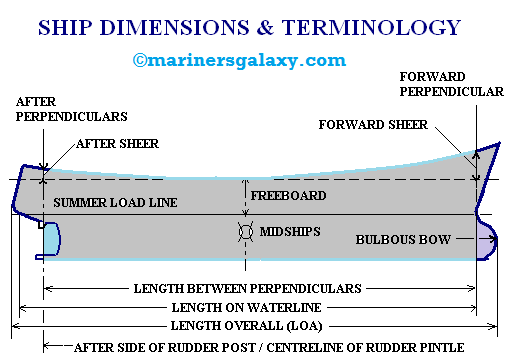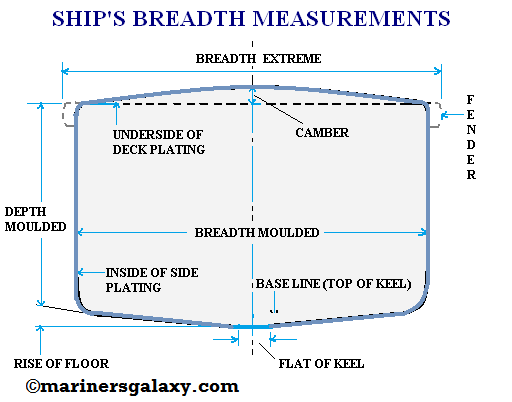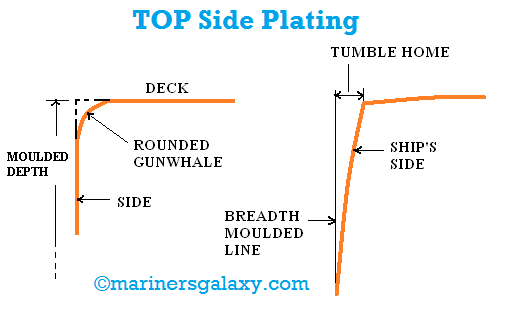The ship is defined in terms of its size and the shape. This is required to find out it’s characteristics for stability, resistance, power needed to run the ship at a particular speed, her seaworthiness, it’s maneuverability, load carrying capacity etc.
Read about the terminology that is used in the naval architecture and ship construction. Also know about the coefficients of forms.
Naval Architecture Terminology
These are mainly length, breadth, depth & the draught.
1 Perpendiculars: these are the imaginary vertical lines drawn on a ship to define the points on the hull forward & aft.
2 Forward perpendicular: A line drawn perpendicular to the water line at the point where the forward edge of the stem intersects the summer load line
3 After perpendicular: A line drawn perpendicular to the water line, where the after
edge of the rudder post/centerline of rudder pintle, meets the summer load line
4 Length Between Perpendiculars (LPP) : This is the distance between the forward and aft perpendiculars measured at the height of summer load line.
5 Amidships/Midship: This is the point midway between the forward and aft perpendiculars.
6 Length Overall (LOA): The distance between the extreme points of the ship forward and aft.
7 Extreme Breadth: This is the maximum measurement between the extreme points, port and starboard.
8 Moulded Breadth: It is the distance from port to starboard measured from the inside edges of the plating.
9 Extreme Depth: This is defined as the distance from the upper deck to the underside of the keel.
10 Extreme Draught: it is the distance from water line to underside of the keel.
11 Base Line: it is the horizontal line drawn along the top edge of the keel from midships.
12 Moulded Depth: it is the distance from the upper deck to the base line, measured at the midship section.
13 Moulded Draught: it is the distance from the summer load line to the base line, measured at midship section.
14 Draught of Ship: it is the distance of the lowest point of the keel below the water line Special shapes have been given to some portion of the ship from practical point of view to serve some purposes
Example:
1. Camber is provided to drain the water from deck.
2. Flare is provided at the fore end to direct the waves away from the fore castle.
1. Camber: it is the curvature of the deck in a transverse direction. It is measured between the deck height at the centre and deck height at the ship’s side.
2. Sheer: This is defined as the curvature of deck, in a longitudinal fore and aft direction. It is measured between the deck heights at midships and the perpendicular point along the deck.
3. Rise of floor: it is the height of bottom shell plating above the base line. This is moulded base line.
4. Bilge radius: it is the radius of plating joining the side shell to the bottom shell. It is measured at midships.
5. Trim: it is the longitudinal inclination of ship, determined by the difference between the forward and the aft draughts. When forward & aft draughts are same, the ship is said to be on an even keel. Down by the head means draught forward is greater. Down by the stern means draught aft is greater.
Coefficient of Forms for Ship
The number of coefficients are used which describe the relation between the ship’s hull form and a surrounding regular shape.
Water plane area coefficient (cw)
It is the ratio of the actual area of the waterplane to the product of the length and breadth of the ship.
Actual Water Plane Area
CW = ………………………………………………………..
Length X Breadth
AW
CW = …………… (1)
L x B
Midship Section Area Coefficient (Cm)
It is the ratio of the actual area of the immersed portion of the ship’s midship section to the product of the breadth and the draught.
Area of Immersed Midship Section
Cm =
————————————————————
Breadth X
Draught
AM
CM = ——— ————————————— (2)
B x d
Block Coefficient (Cb)
Block Coefficient defined as the ratio of the volume of displacement (Actual) to the product of the length, breadth and draught. See the figure above
Actual Volume Of Displacement
Cb =………………………………………………….
Length X Breadth
X Draught
▼
Cb=
……………………(3)
L
x B x d
Prismatic Coefficient (Cp)
Prismatic Coefficient is the volume of displacement to the product of the length and the actual area of the immersed portion of the midship section.
Volume of Displacement (Actual)
Cp = ………………………………………………………………….
Length X Area of Immersed Midship
Section
▼
CP
= ………………4)
L x Am
Wetted Surface Area (Aw)
This is the area of the ship’s hull, which is in contact with the water (surface area of the immersed part of hull). This area can be found out by using the empirical formulae.
DENNY’S
FORMULA S = 1.7 L d + ▼/d ……………… (1)
TAYLOR’S
FORMULA S = C Δ L ………………2)
where s = wetted surface area
L = LENGTH OF SHIP IN m
d = DRAUGHT IN m
▼= VOLUME OF DISPLACEMENT IN m3
Δ = DISPLACEMENT IN TONNE
C = COEFFICIENT = 2.6 (depends on shape
of the ship)
Note: Cp X Cm = Cb
Similar Figures in Ship Construction
Two lines, planes or bodies are said to be similar when their linear dimensions are in the same ratio.
Example: Project image of small figure on slide to that of a bigger figure on screen two circles of different diameter. The area of similar figure vary as the square of their corresponding dimensions consider two circles of diameter ‘D’ and ‘d’. Then
Area of larger circle D2
—————————————- = —– —————–(1)
Area of small circle d2
IF ‘D’ IS twice ‘d’, then area of former is four times the area of the latter.
&
A1 L12 B12
—— = —— = ——- ————————————–(2)
A2 L22 B22
Volume of similar bodies varies as the cube of their corresponding dimensions.
Consider two spheres of diameter ‘D’ and ‘d’.
Volume of Larger Sphere D3
——————————————- = ——- ———- (1)
Volume of Small Sphere d3
If ‘D’ is twice the diameter‘d’, then volume of former is eight times the volume of the latter.
V1 L13 B13 D13
—– = —– = —— = —– ———————————(2)
V2 L2 3 B23 D23
Above rules may be applied to similar bodies, no matter what their shape is. Similarly it can be applied to ships of any shape. And is quite useful in their construction of ships, when its prototype is being made.
If L = length of ship, Δ = displacement & S = wetted surface area then
S ∝ L2 …….(1)
Δ ∝ L3 ……. (2)
S ∝ Δ2/3 ……. (3)
Δ ∝ S3/2 ……. (4)
Δ1 L13
—– ∝ —– ……. (5)
Δ2 L23
S1 L12
—– ∝ —– ……. (6)
S2 L22
So this was all from this article, hope you liked reading this topic of Ship Terminology and Coefficients of Form.







It’s very useful & very helpful for mariners. Thanks a lot.